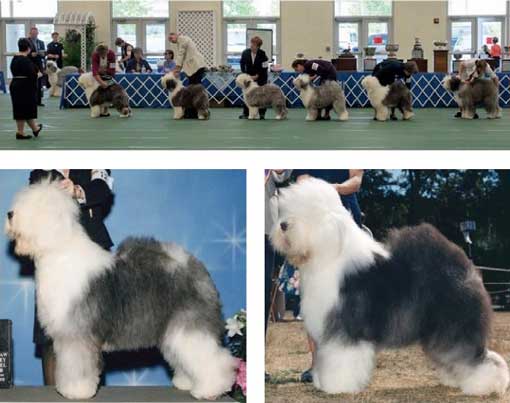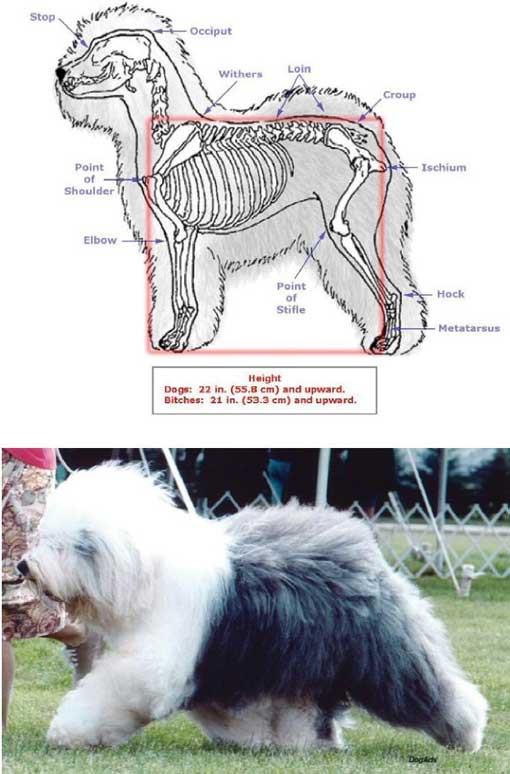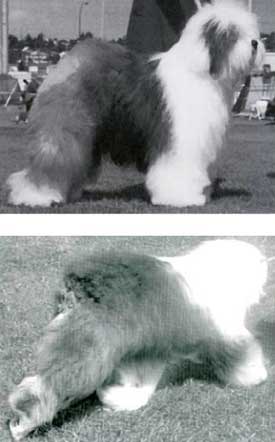Judging: Priorities and Evaluation
Priorities and Evaluating the Old English Sheepdog in the Show Ring
Written by Breeder Judge Mary Anne Brocious
When judges enter the ring a fresh thought process begins for each breed. Of course there is a different breed standard with each breed and different functionality for the respective breeds. We think differently with each breed. What are the primary Hallmarks of the breed in front of us that make it what it is and which dog is most compliant to those characteristics. How do we get there with each class of dogs? Many judges often wait to add the Old English Sheepdog to their credentials after they have had more judging experience. The coat and certain characteristics seem more challenging than most breeds. The OES is still a dog with the usual canine anatomy and breed specific features that we look for in every breed we judge. The AKC has approved you to judge the Old English Sheepdog, you know the breed standard, you know canine anatomy, you know ring procedure and I will help you organize your thoughts when judging the OES.
“THE COAT AND CERTAIN CHARACTERISTICS SEEM MORE CHALLENGING THAN MOST BREEDS.”
Percy Roberts once said, “The Breed Standard is the Blueprint, The Breeder is the Builder, and the Judge is the Building Inspector.” So, let's get down to inspecting what the breeder has built! When your class enters the ring the first thing you will realize is that the OES is not a silhouette breed. Each exhibit looks different by virtue of various styles of grooming. While the breed standard calls for coat on the head, neck, front legs and thighs, and he must have a shaggy appearance the methods used to arrange and present the coat varies from dog to dog. From this first look you will have to determine which dogs have a shaggy appearance and appear strong, compact, square and balanced.
“BOTH GOOD AND BAD QUALITIES MAY BE HIDDEN IN THE COAT.
EVERYTHING WILL BE SIMPLIFIED WHEN YOU GET PAST THE COAT.”
 The next step will have your class circle the ring to get your first glimpse of their movement. You are watching for the motion of an agile dog with movement that is free, powerful and effortless. The dogs should have “good reach and drive and cover maximum ground with minimum steps”. Be aware that the coat can distort your impression of the movement. You must watch for the extension of the front and rear legs for balanced reach and drive. Watch to see that the body stays square and that the topline is visible when the dog is in motion. Yes, these assessments have to be done with a dog that is covered in a blanket of coat and in about 20 seconds! You will watch the legs, body and topline as you would any other breed and learn, with time, to see through the coat. No, you won't acquire x-ray vision, but you will begin to see how the dog will push from his rear feet and extend forward with his front legs using correct front angles. You will be able to determine if the dogs tend to get longer and lower as they move and lose squareness. In addition you will want to see the gentle rise over the loin as the dogs trot.
The next step will have your class circle the ring to get your first glimpse of their movement. You are watching for the motion of an agile dog with movement that is free, powerful and effortless. The dogs should have “good reach and drive and cover maximum ground with minimum steps”. Be aware that the coat can distort your impression of the movement. You must watch for the extension of the front and rear legs for balanced reach and drive. Watch to see that the body stays square and that the topline is visible when the dog is in motion. Yes, these assessments have to be done with a dog that is covered in a blanket of coat and in about 20 seconds! You will watch the legs, body and topline as you would any other breed and learn, with time, to see through the coat. No, you won't acquire x-ray vision, but you will begin to see how the dog will push from his rear feet and extend forward with his front legs using correct front angles. You will be able to determine if the dogs tend to get longer and lower as they move and lose squareness. In addition you will want to see the gentle rise over the loin as the dogs trot.
Now the individual examination is where the “rubber-meets-the-road”! You cannot just feel the surface of an OES when you examine the dogs. You must go through the hair to feel the actual structure of each dog. The entire time that you are examining an OES you must think about what you are feeling and place it in your “mind's eye”. Both good and bad qualities may be hidden in the coat. Everything will be simplified when you get past the coat. When examining each dog roll a checklist through your mind. From your training and experience you know what each of the features of the dog should be and you will know from your examination if you can check off these features as being correct or incorrect. Some countries, such as Canada, use a point scale that accompanies the standard, and judges will often calculate the points per feature on each exhibit as they examine and observe movement.
EXAMINATION CHECKLIST
- Nose, Bite and Eye Color
- Muzzle Shape and Fit and Head Shape
- Neck Length and Arch
- Fit of Neck into the Shoulders
- Shoulder layback and angles
- Depth of Chest and Spring of Rib
- Straightness of Front Legs and Feet
- Topline
- Length of Loin
- Croup
- Rear Stifle Angulation
- Well let-down hocks
- Not Cow Hocked
- Bone and Substance
- Double Coat
- Texture of Coat and Overall Condition of the Coat
- Balance, Proportion and Squareness
While this checklist may appear lengthy, as your hands move through the dog's coat each feature is seen with your hands, and you will move quickly as you examine every component. This check list should roll through your mind as you examine each dog and you must remember which dogs complied most closely with the breed standard and correct canine anatomy and which dogs did not.
Following your examination you will have each dog go down the mat and back to you. From this view coat may influence your perception of the way an OES is moving. A lot of coat on the front may make a dog look out at the elbows or even a little sloppy. Otherwise don't be fooled by all of the hair on an overly wide front that does not converge. An untrimmed hindquarter can look close and markings on the legs may give a false impression of movement. When the dog goes away watch the pads coming up and when you see the bottom of the feet watch how the feet fall with each step.
When the dog completes the down and back he will then circle the ring to the end of the line. When watching each dog move to the end of the line you will watch the front to see that it reaches easily and smoothly without hitching, rolling, waddling or hackney movement. Watch for the rear to drive straight back without any wasted motion such as kicking up. Watch that the dog remains square and the topline is visible in motion.
The final look at the lineup of the class will have you review the checklist in your mind and recall the movement of each dog. After this review you will eliminate dogs from a placement and determine which dogs you will use for your placements. Set your priorities. Which dog has the best Balance and Proportion, Head, Topline, Coat and Movement and select your placements and determine what trade-offs you will make in selecting your four placements. You will now rank the dogs from the one that most closely matches the breed standard and canine anatomy through to the dogs that may not comply as closely as your first choice.
All of this has to be done in 2 minutes per dog. While 2 minutes per dog may not seem to be enough time, we must be prepared to evaluate them in the time the AKC requires. The Old English Sheepdog is not a difficult breed to evaluate if you follow the steps that I have outlined. Each time you judge the OES it will become easier to evaluate and find the dogs that are most compliant with the Breed Standard.
Please enjoy this agile, athletic Herding dog when judging. When trained and presented at their best you will find the Old English Sheepdog to be a pleasure to have in your ring.
Reprinted with permission from ShowSight Magazine, March 2015
Author's Note—In an effort to include helpful information and useful tips to the readers I asked other OES specialist judges to share their approaches and thought processes for the benefit of the readers. Information from Terry Carter, Some Buddy OES; Martin Doherty, Auriga OES; Davor Javor, Reata OES; and Chris Moore, Perfu OES; and Marilyn O'Cuilinn, Merryrogue was included in this article. A special note of thanks to Dennis Maier for his photo contributions and content management of OESCA Judges Education materials.
ABOUT THE AUTHOR
 Mary Anne has experience as an exhibitor, breeder, dog club official and judge.
Mary Anne has experience as an exhibitor, breeder, dog club official and judge.
Mary Anne began breeding and exhibiting Old English Sheepdogs in 1973 and has bred and owned over 100 OES Champions under the Qubic prefix. Qubic OES have won BIS, BISS, many group wins and placements at AKC events and many have championships in foreign countries. At the 2012 OESCA National Specialty Qubic OES were Winners Dog, Winners Bitch, Best of Winners and Best of Breed. Qubic OES have received awards for Top Producing Sires and Dams and Register of Merit awards from the Old English Sheepdog Dog Club of America. While the breeding pro-gram has remained small, she is proud to have maintained high standards of health and temperament in her dogs.
Mary Anne has served as a club officer, AKC Delegate and is a Life Member of the Ann Arbor Kennel Club where she is currently Show Chair. Mary Anne serves as Judges Education Chair for the Old English Sheepdog Club of America. In 2013 Mary Anne was selected as Herding Breeder of the Year by the Santa Barbara Kennel Club. She is approved by the AKC to judge all Working and Herding Breeds, PBGVs and Best In Show. In addition to judging in the US, Mary Anne has judged in Australia, China, South Africa, Taiwan, Mexico, Canada, Germany, Denmark and Finland.




